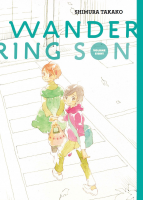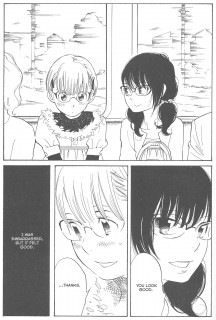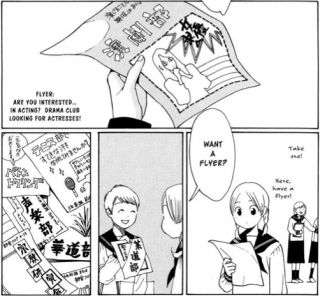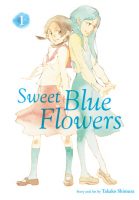 Creator: Takako Shimura
Creator: Takako Shimura
Translator: John Werry
U.S. publisher: Viz Media
ISBN: 9781421592985
Released: September 2017
Original release: 2005-2006
Takako Shimura is probably best known for two manga series. The first, and my introduction to her work, is Wandering Son, a series which sympathetically explores some of the challenges faced by transgender and gender non-conforming youth. (Wandering Son is an incredibly important manga to me personally and I will forever lament the fact that it will likely never be released in English in its entirety.) The second manga is Sweet Blue Flowers, another series with queer themes, this time focusing on bisexual young woman and lesbian teenagers. While the anime adaptation of Sweet Blue Flowers has been readily available in English for years, the publication history of Shimura’s original manga has been more fraught. Originally translated in 2012 as part of the failed JManga digital initiative, the first volume was subsequently released by Digital Manga in a less than stellar ebook version after which the series languished unfinished. Surprisingly, Sweet Blue Flowers would be rescued by Viz Media, making it one of the first yuri manga to ever be released by the publisher. The first print omnibus of the Viz Signature edition of Sweet Blue Flowers, collecting the first and second volumes of the series originally published in Japan in 2005 and 2006, was easily one of my most anticipated debuts of 2017.
Fumi Manjome and Akira Okudaira were very close as children but the two girls fell out of touch after Fumi’s family moved away. Many years later they meet again by chance while commuting by train on the way to their first day of high school. They don’t actually realize who the other one is at first, but soon Fumi and Akira’s friendship is rekindled and their relationship blossoms once more. Since they attend different all-girls schools they don’t get a chance to see each other as much as they might like, though. Even so, both Akira and Fumi are faced with some similar trials which bring them together–making friends at their new schools and finding an extracurricular club to join that interests them among other things–but not everything is the same for them. Although complimentary, the two young women have strikingly different personalities, resulting in drastically different experiences and interactions. And while Akira doesn’t seem to have put much thought into romance, Fumi has recently had her heart broken. But now Fumi has fallen for an older student at her school, Yasuko Sugimoto, a young woman who is interested in Fumi but who is also dealing with an unrequited love of her own.
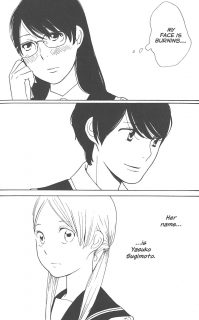 Shimura’s artwork in Sweet Blue Flowers is simple and refined, but is still able to carry the emotional weight and expressiveness of the story. The focus of the manga’s illustrations is almost entirely on the characters themselves. Except for when the actual setting is intended to make an impact, such as the hallowed halls of a prestigious school or the imposing home of a distinguished family, backgrounds are minimalistic and sometimes even non-existent. Just enough is implied to give readers an impression of place and location. This technique, along with Shimura’s use of light and shadow, is reminiscent of intentionally minimal set design used in some theatrical performances which in turn nicely echoes the high school stage production of Wuthering Heights featured prominently in the first omnibus of Sweet Blue Flowers. The characters’ involvement with the play is an important part of the series both aesthetically and thematically. The connections to theater and creative performance arts present in Sweet Blue Flowers can also be found in Shimura’s other work, including but not limited to Wandering Son.
Shimura’s artwork in Sweet Blue Flowers is simple and refined, but is still able to carry the emotional weight and expressiveness of the story. The focus of the manga’s illustrations is almost entirely on the characters themselves. Except for when the actual setting is intended to make an impact, such as the hallowed halls of a prestigious school or the imposing home of a distinguished family, backgrounds are minimalistic and sometimes even non-existent. Just enough is implied to give readers an impression of place and location. This technique, along with Shimura’s use of light and shadow, is reminiscent of intentionally minimal set design used in some theatrical performances which in turn nicely echoes the high school stage production of Wuthering Heights featured prominently in the first omnibus of Sweet Blue Flowers. The characters’ involvement with the play is an important part of the series both aesthetically and thematically. The connections to theater and creative performance arts present in Sweet Blue Flowers can also be found in Shimura’s other work, including but not limited to Wandering Son.
Sweet Blue Flowers is a wonderful series. The manga is emotionally resonate, with a realistic portrayal of the experiences of young women who love other young women. The characterizations and character development in Sweet Blue Flowers in particular are marvelous. Shimura effectively captures the nuances of a multitude of personalities and how they interact with one another, showing both individuals and their relationships as believably layered and convincingly complex. Sweet Blue Flowers is a relatively quiet story, but the emotional drama is powerful and the manga conveys a compelling sense of authenticity and honesty. I am loving the series and find that I am completely invested in the lives and well-being of Fumi, Akira, and the other characters as they navigate their adolescence. Life and relationships can be challenging and messy, something that Shimura does not shy away from in the manga. The young women in Sweet Blue Flowers grow and change, gaining maturity through their mistakes and missteps as well as personal clarity as they slowly discover their own identities. Sweet Blue Flowers is a worthwhile and lovely work; I’m so glad that it’s finally receiving a proper release in English.

